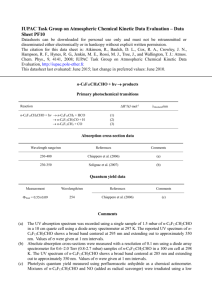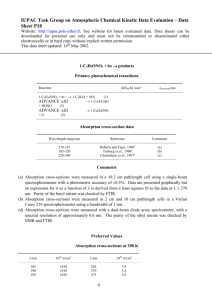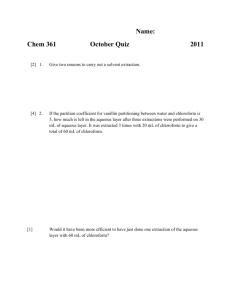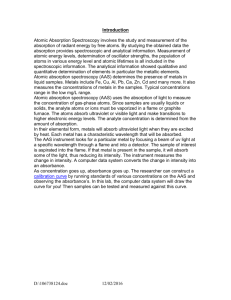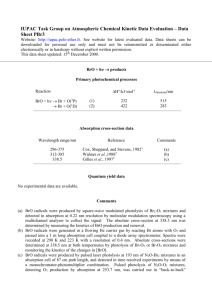Data Sheet PI11 - IUPAC Task Group on Atmospheric Chemical
advertisement
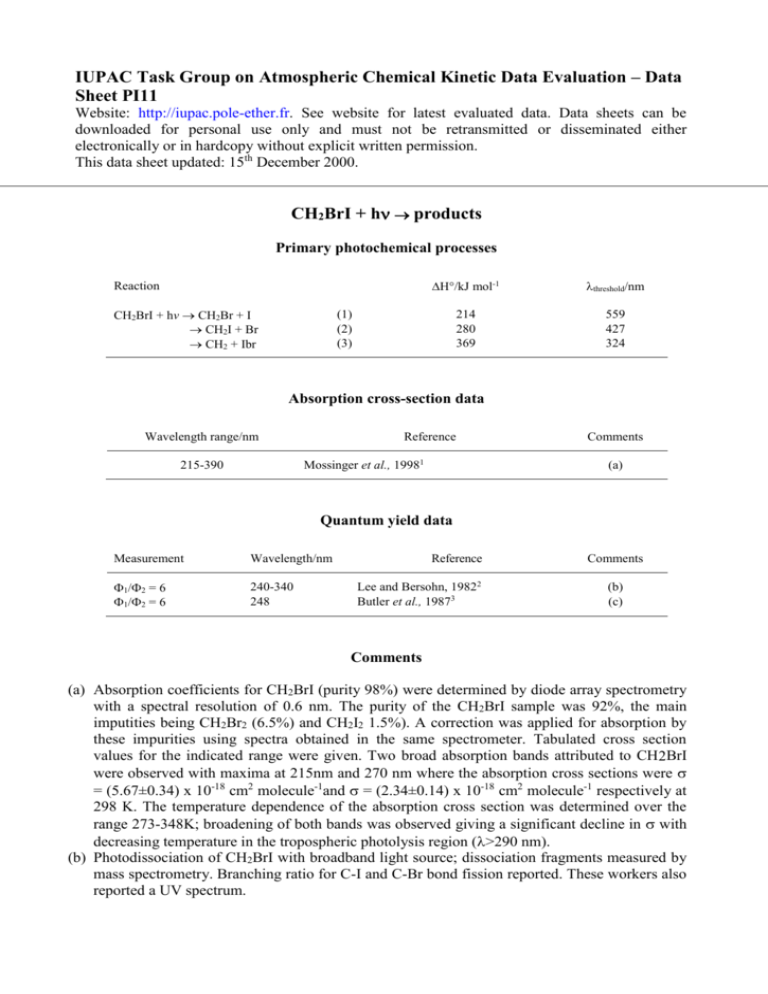
IUPAC Task Group on Atmospheric Chemical Kinetic Data Evaluation – Data Sheet PI11 Website: http://iupac.pole-ether.fr. See website for latest evaluated data. Data sheets can be downloaded for personal use only and must not be retransmitted or disseminated either electronically or in hardcopy without explicit written permission. This data sheet updated: 15th December 2000. CH2BrI + h products Primary photochemical processes Reaction CH2BrI + hv CH2Br + I CH2I + Br CH2 + Ibr H/kJ mol-1 threshold/nm 214 280 369 559 427 324 (1) (2) (3) Absorption cross-section data Wavelength range/nm Reference Mossinger et al., 19981 215-390 Comments (a) Quantum yield data Measurement Wavelength/nm 1/2 = 6 1/2 = 6 240-340 248 Reference Lee and Bersohn, 19822 Butler et al., 19873 Comments (b) (c) Comments (a) Absorption coefficients for CH2BrI (purity 98%) were determined by diode array spectrometry with a spectral resolution of 0.6 nm. The purity of the CH2BrI sample was 92%, the main imputities being CH2Br2 (6.5%) and CH2I2 1.5%). A correction was applied for absorption by these impurities using spectra obtained in the same spectrometer. Tabulated cross section values for the indicated range were given. Two broad absorption bands attributed to CH2BrI were observed with maxima at 215nm and 270 nm where the absorption cross sections were = (5.67±0.34) x 10-18 cm2 molecule-1and = (2.34±0.14) x 10-18 cm2 molecule-1 respectively at 298 K. The temperature dependence of the absorption cross section was determined over the range 273-348K; broadening of both bands was observed giving a significant decline in with decreasing temperature in the tropospheric photolysis region (>290 nm). (b) Photodissociation of CH2BrI with broadband light source; dissociation fragments measured by mass spectrometry. Branching ratio for C-I and C-Br bond fission reported. These workers also reported a UV spectrum. (c) Product state distributions measured for laser photodissociation CH2BrI at 193.3, 210, and 248.5 nm of in a molecular beam, using TOF-MS. At 248.5 nm both C-I and C-Br bond fission occurs, with I formation dominant, producing ground state 2P3/2 and excited state 2P1/2 atoms in ratio of 1.0:0.75. At shorter wavelengths elimination of IBr was observed also. Preferred Values Absorption cross-sections for CH2BrI at 298 K Wavelength/nm 1020/cm2 103B/K-1 215 220 225 230 235 240 245 250 255 260 265 270 275 280 285 290 295 300 305 310 315 320 325 330 335 340 345 350 355 360 365 370 375 380 385 390 567 423 269 155 97.9 80.9 93.7 125 170 207 228 229 214 184 150 110 82.5 60.6 42.9 31.4 23.1 16.8 11.5 8.02 5.52 3.50 2.24 1.41 0.817 0.498 0.302 0.165 0.098 0.070 0.039 0.025 -2.16 -0.12 1.34 2.06 2.05 1.01 0.0 -0.58 -1.16 -1.29 -1.45 -1.73 -1.22 -0.94 -0.53 0.1 0.63 1.03 1.13 1.41 1.52 1.71 2.36 2.99 3.89 4.79 5.74 6.73 9.47 11.5 11.6 14.3 17.4 Temperature dependence given by: ln = ln (298) + B(T-298/K) Quantum Yield 1 = 1.0 over the range 290-380 nm. Comments on Preferred Values The.preferred values for the cross-sections and the temperature dependence are those of Mossinger et al.1, which appears to be the only reported study where absolute cross section were reported. Cross- sections obtained for other halocarbons by this group agree well with other literature data and the CH2BrI data can be considered reliable. The absorption spectrum agrees with earlier reported spectra2,3 which show two broad bands peaking at 270 nm and 215 nm which are assigned to promotion of electrons from non-bonding orbitals in the C-I and C-Br bonds respectively. The photodissociation of CH2BrI via reaction (1) is expected to occur in the first absorption band with a quantum yield of unity, in line with other alkyl iodides. Studies of the photodissociation fragments2 show that reaction (2) is dominant following absorption in the second band at 210 nm and that both processes occur in the region where the bands overlap. In the region for tropospheric photolysis (>290 nm) reaction (1) will dominate. 1 2 3 References J. C. Mossinger, D. E. Shallcross, and R. A. Cox, J. Chem. Soc. Farad. Trans. 94, 1391 (1998). S. J. Lee and R. Bersohn, J. Phys. Chem. 86, 728 (1982). L. J. Butler, E. J. Hintsa, S. F. Shane, and Y. T. Lee, J. Phys. Chem. 86, 2051 (1987).


